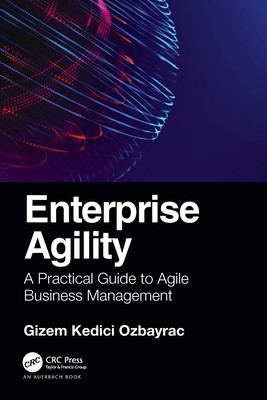
- We will send in 10–14 business days.
- Author: Gizem Ozbayrac
- Publisher: Auerbach Publications
- ISBN-10: 1032139099
- ISBN-13: 9781032139098
- Format: 15.6 x 23.4 x 0.9 cm, softcover
- Language: English
- SAVE -10% with code: EXTRA
Reviews
Description
Despite the astonishing technological developments in our times, it is surprising how little has changed in the way organizations are structured and managed. However, organizations are finally changing as they embark on agile transformations.
Agility concepts emerged from the dynamics of project management and have evolved as they are being applied to organizational structure and operations. This phase of the agile evolution is known as enterprise agility.
Filled with real-world scenarios and company case studies, Enterprise Agility: A Practical Guide to Agile Business Management covers the evolution of agility, including applied processes, lessons learned and realized outcomes. The book starts with the initial phase of the agile evolution, project agility and describes how waterfall project management is transformed into scrum, which can have positive effects on project timelines, scope and budget, as well as team motivation. The second phase of agility, organizational agility, is the evolution of the agile principles from temporary projects to permanent organizational structures. The book explains the main components of organizational agility, including structures, roles and ways of organizing work. It emphasizes the advantages of transitioning from traditional organizational management to agile. Finally, the latest phase, enterprise agility, transforms each function of the organization. The book acts as a guide and describes the change through the lens of each managerial domain (sales, marketing, HR, finance etc.) and by presenting the positive impact generated on the company's overall performance based on case studies.
The last chapter illustrates the enablers of this transformation and how they can help the change to be internalized so that the enterprises realize improvements.
The book is based on the author's over 15 years of experience of supporting more than 25 companies in varied sectors on their transformational journey, with the last 5 years concentrating on agility. By combining business management trends and principles of agile business development, it shows managers how to lead the transformation to enterprise agility by following the path from project agility to full enterprise agility.
EXTRA 10 % discount with code: EXTRA
The promotion ends in 19d.00:00:43
The discount code is valid when purchasing from 10 €. Discounts do not stack.
- Author: Gizem Ozbayrac
- Publisher: Auerbach Publications
- ISBN-10: 1032139099
- ISBN-13: 9781032139098
- Format: 15.6 x 23.4 x 0.9 cm, softcover
- Language: English English
Despite the astonishing technological developments in our times, it is surprising how little has changed in the way organizations are structured and managed. However, organizations are finally changing as they embark on agile transformations.
Agility concepts emerged from the dynamics of project management and have evolved as they are being applied to organizational structure and operations. This phase of the agile evolution is known as enterprise agility.
Filled with real-world scenarios and company case studies, Enterprise Agility: A Practical Guide to Agile Business Management covers the evolution of agility, including applied processes, lessons learned and realized outcomes. The book starts with the initial phase of the agile evolution, project agility and describes how waterfall project management is transformed into scrum, which can have positive effects on project timelines, scope and budget, as well as team motivation. The second phase of agility, organizational agility, is the evolution of the agile principles from temporary projects to permanent organizational structures. The book explains the main components of organizational agility, including structures, roles and ways of organizing work. It emphasizes the advantages of transitioning from traditional organizational management to agile. Finally, the latest phase, enterprise agility, transforms each function of the organization. The book acts as a guide and describes the change through the lens of each managerial domain (sales, marketing, HR, finance etc.) and by presenting the positive impact generated on the company's overall performance based on case studies.
The last chapter illustrates the enablers of this transformation and how they can help the change to be internalized so that the enterprises realize improvements.
The book is based on the author's over 15 years of experience of supporting more than 25 companies in varied sectors on their transformational journey, with the last 5 years concentrating on agility. By combining business management trends and principles of agile business development, it shows managers how to lead the transformation to enterprise agility by following the path from project agility to full enterprise agility.


Reviews